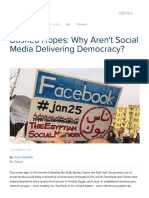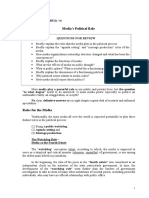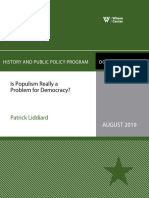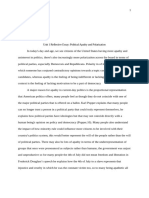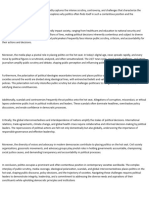0 ratings0% found this document useful (0 votes)
15 viewsKhushi Assignment
Khushi Assignment
Uploaded by
manshinain08Copyright:
© All Rights Reserved
Available Formats
Download as DOCX, PDF, TXT or read online from Scribd
Khushi Assignment
Khushi Assignment
Uploaded by
manshinain080 ratings0% found this document useful (0 votes)
15 views14 pagesOriginal Title
KHUSHI ASSIGNMENT
Copyright
© © All Rights Reserved
Available Formats
DOCX, PDF, TXT or read online from Scribd
Share this document
Did you find this document useful?
Is this content inappropriate?
Copyright:
© All Rights Reserved
Available Formats
Download as DOCX, PDF, TXT or read online from Scribd
Download as docx, pdf, or txt
0 ratings0% found this document useful (0 votes)
15 views14 pagesKhushi Assignment
Khushi Assignment
Uploaded by
manshinain08Copyright:
© All Rights Reserved
Available Formats
Download as DOCX, PDF, TXT or read online from Scribd
Download as docx, pdf, or txt
You are on page 1of 14
NAME = KHUSHI
ROLL NO = 23/0418
POLITICAL COMMUNICATION
WHAT IS POLITICAL COMMUNICATION?
DEFINATION
Political communication is the process by which language
and symbols , employed by leaders, media, or citizens, exert
intended or unintended effects on the political cognitions,
attitudes, or behaviours of individuals or on outcomes that
bear on the public on the public policy of a nation, state, or
community.
The definition emphasize that political communication is a
process. It does not occur with the flick of a wrist, or flipping
of a leave. A president can propose a particular initiative, but
to turn an idea into a credible bill and a bill into law, the chief
executive must persuade congress, which involves multiple
influence attempts on legislators, mediated by countless
communiques with the public. A journalistic expose of
corporate malfeasance that produces a policy change does
not magically exert an impact. Instead, it unleashed a variety
of forces, including changes in public opinion, which, through
poll results, influence policymakers, who, themselves, must
consider the most effective and politically advantageous way
of altering policy.
Political communication calls centrally on words and symbols.
Political communication can be viewed “the practice of using
language to move people to think and act in way that they
might not otherwise think or act”. Leaders harness the power
of language – colourful phrases, apt metaphors, syntax, and
rhythm to mold attitudes and move citizens.
The language of political communication is laden with
symbols. A symbol is a form of language in which one entity
represents an idea or concept, conveying rich psychological
and cultural meaning. Symbols include words like justice,
freedom, and equality, and non-verbal sings like the flag or a
religious cross. In America, elected officials frequently invoke
the American flag, the founding fathers, Lincoln, Jefferson,
freedom, liberty, and equality.
Political communication involves the transfer of symbolic
meanings, the communication of highly charged emotional
words that can arouse, agitate, and disgust. Words convey
different meanings to different groups. To conservatives,
freedom conjures up immigrants’ dreams of owning a
business in the USA or practicing religion as they see fit. To
liberals and minorities, freedom calls to mind the opportunity
to display one’s own creed publicly without fear of prejudice.
It also conveys empowerment, the way a previously
victimized group can throw the shackles of oppression,
openly expressing its own cherished values. Political
messages calls up different meanings to different groups, an
inevitable source of friction and conflict in democratic
societies.
There are three main players in political communication:
The first is the broad group of leaders and influence
agents. These are the “elites” of politics, who include
elected officials, as well as the plethora of Washington,
D.C opinion leaders spanning members of the
president’s cabinet, policy experts, and chieftain in the
vast government bureaucracy.
The next player or players are the media. This
increasingly diverse group includes the conventional
news media, bloggers, people armed with a cell phone
camera and an attitude who call themselves citizen-
journalists, partisan promulgators of websites, and the
gaggle of political entertainment hosts and comedians.
The centerpiece of political communication is the
citizenry. Citizens are a cacophonous combination of the
politically engaged and opinionated, along with the
indifferent and woefully ignorant. The citizenry includes
those who actively partake in civic groups for example,
pro-life and pro-choice; evangelical Christian and
unabashedly atheist wall street investors and blue collar
unions, as well as pro and anti-fur, vegan, and virulently
pro-red-meat.
Political communication effects can be intended or
unintended. A presidential speech is intended to influence,
and a flurry of favorable emails and text messages received
at the White House after the speech are examples of
intended effects. A negative political advertisement is
designed to cause voters to evaluate the targeted
candidate more unfavorably, and declines in the attacked
candidate’s poll ratings illustrate an intended
communication effect. But not communication effects are
intended by the communicator.
Political communication also encompasses news, relayed on
television and via the internet. It also includes rush
Limbaugh, homer Simpson, family guy’s peter griffin, south
park’s stan marsh, political talk radio, you tube videos,
Facebook posts, and other media content that touches on
what people think and feel about politics. Political
communication involves more than media. It includes old –
fashioned dinner table political arguments, trying to persuade
a friend to join a campus protest, and knocking on doors on
wintery mornings to gather signatures for a state – wide
petition.
Political media exert influence on the micro level, affecting
individuals’ thoughts, candidate assessments, feelings,
attitudes, and behaviour. The first 2012 presidential debate,
in which Obama seemed lethargic, exerted a micro level
impact if it led an undecided voter to rethink her support for
Obama.
Political communication also works on the macro level,
exerting broad-based effect on public opinion, institutional
change or retrenchment, political activism, and public policy.
CONTEMPORARY POLITICAL COMMUNICATION
Political communication involves more than just the words,
“political” and “communication.” Delving deeper, scholar
conclude that there are five core features of today’s political
communication.
1. Political communication involves three key players:
LEADERS
MEDIA
PUBLIC
There are different perspective on which of these three
group exerts the greatest impact. Scholars argue that
under different circumstance, leaders, media, and the
public have the strongest influence.
One view is that elite leaders exert a preeminent
impact on opinions and policy. After the tragedy of
September 11, the nation looked to the president, as it
often does in national crises. Addressing a joint session
of congress and the nation on September 20, 2001 ,
George W . Bush gave a moving speech, in which he
spoke of “a country awakened to danger and called to
defend freedom” and articulated the threats the nation
faced from terrorist groups, while taking pains to show
respect for Muslims in America and throughout the
world. Though his rhetoric and actions, Bush rallied the
country around a new and unsettling war on terror.
More than a year later, the same president was under
siege, accused of using the communicative powers of
his office to launce an unnecessary war on Iraq. As two
scholars noted, critics advanced “the serious and
plausible suggestion that the Bush admin-istration
‘manipulated’ the country into war [with Iraq] through
a variety of techniques: controlled leaks to the press,
exploitation of jingoistic sentiment, cherry- picking of
vital intelligence, and stagecraft designed to reinforce
the government’s daily message at the expense of a full
public dialogue in the question of war”
Not all political observer would agree with this
evaluation of Bush’s action. But there is little doubt
that he aggressively used political language, news
management, and public appearances to advance his
view that the Iraq war was essential to protect U.S
security. Dominate the national agenda.
A second view places the onus on media. It emphasize
that the media exert a preeminent effect on the
conduct of politics. This view point notes that the news
media’s choice of issues, and the way they frame the
news, can influence leaders and public.
For example, some observer argue that the news
media frequently called the press paved the way for
the Barak Obama’s nomination back in 2008. Obama
was attractive and charismatic, qualities that can
captivate a television audience. He was initially an
underdog. The press likes to push underdogs who
challenge the status quo. As he started to gain in the
polls and win primaries, he gained political ground,
creating a bandwagon effect, producing even more
favorable press coverage. Obama also received
substantially more positive press coverage than his
opponent for the democratic nomination, Hillary
Clinton. Some scholars maintained that the press gave
Obama better coverage because he powered together
an unstoppable political juggernaut that captivated so
many young voters, while other pointed to suggestive
evidence of press bias on the part of journalists. In
either case, the favorable press coverage netted him
momentum, a key commodity in primary campaigns
that helps to propel candidates to victory.
A third viewpoint argues that the public calls the shots.
In order to get elected and reelected, leaders have to
be responsive to their constituents, implementing
polices that the average voter supports. For example, in
2012 election, the state of the economy, with the
unrelentingly high unemployment rate, was the most
important issue to the public. The media this is a
preeminent part of its coverage. It formed the
centerpiece of republican attacks against Obama and
provided the backdrop of Obama’s strategy of blaming
republicans for blocking his legislative proposals to
improve the nation’s economy. The electorate or voting
public helped push the issue to the fort and center for
both candidates and media.
In most political context, all three influence agent
elites, media, and public interact in complex way. The
drama of political communication involves a trifecta:
leaders, media, and citizens symbolically jousting
among themselves and framing problems in different
ways. The key, of course, is power: leaders invoke
language, symbols, and the trapping of their offices to
gain and maintain power. Media relay, interpret,
challenge, or reinforce the use of power. Citizens, some
more than others, the richer and better-connected
more than the poorer and less-educated, become
involved in the political process, wielding morden
communication to advocate for causes and candidates,
sometimes wisely, other time foolishly.
2.POLITICS IS PLAYED ON A MEDIA PLATFORM:
Media are our primary points of access to politics…and
the place for political encounters that precede, shape,
and at times determine further bodily participation.
Furthermore, those encounters occur through a
panoply of media forms (books, magazines,
newspapers, newsletters, billboards and
advertisement, direct mail, radio, film, emails,
websites, blog, social networking sites, and, of course,
cable and network television) and across numerous
fictional and nonfictional genres… such encounters do
much more than provide “information” about political
ideas, issues, events, or players. They constitute our
mental maps of the political and social world outside
our direct experience.
3. TECHNOLOGY IS A CENTERPIECE OF POLITICAL
COMMUNICATION :
The technological revolution has had two major
influences. It has vastly increased the supply of the
information, with conventional media, websites galore,
blogs, and politically oriented social media posts
offering a plethora of facts and opinions about politics,
technology has also greatly expanded choices, with a
wealth of source and channels available to people.
Political information that would be formerly kept
inside the recesses of government is now public,
porous, and (for better and sometimes for worse) out
there for citizens to peruse. Thus, WikiLeaks, a non-
profit organization dedicated to releasing classified
documents, revealed classified information on the
conduct of war and foreign diplomacy, obtained from
news leaks and whistleblowers.
MEDIA are technology that intercede between the
communicator and message recipient, filtering the
message through the selection of words, images, and
formats, newspapers, magazines, and television make
up conventional, sometimes called mainstream, media.
They convey a message to the audience, ignoring,
selecting, shaping, and framing information based on a
host of factors. Is the internet media? It is a question
frequently asked, but one that is difficult to crisply
answer.
The internet is not a medium, but a series of
interlocking digital network that convey information
that has been interpreted and mediated by traditional
media like newspaper and television, as well as other
outlets, like blog and websites. The internet is a
technological platform that facilitates direct interaction
between the communicator and message receiver. It
includes sites maintained by the mainstream media, as
well as online news organizations, blogs and partisan
fare. And then there are social media for example, the
ubiquitous twitter and facebook. Some observers say
that all these new technologies constitute the new
middlemen. Rather than simply facilitating mediation,
whereby media come between sources and receivers,
they produce “disintermediation” , whereby people
circumvent media and communicate directly with
leaders.
The internet yanked power from the news media and
gave it to people, enabling ordinary people to
participate more actively in public dialogue. This is all
to the good when it connects citizens with leaders in
civilized dialogues or allows people to communicate
about politics with others via Facebook and Twitter.
The internet’s role in communication is more freighted
and controversial when partisans launce vicious,
prejudiced invectives against public official or other
users with whom they disagree, shielded by the privacy
of a PC in a living room or a cell phone in a
coffeehouse.
4. POLITICAL COMMUNICATION HAS GONE GLOBAL :
the most noteworthy aspect of the globalization of
political communication technology is that any
individual with the technical knowledge to create a
Facebook page or distribute an image on You Tube can
influence politics. The most dramatic example occurred
in 2011 in Cairo, Egypt, or, more precisely, in
cyberspace, when a google executive, Whalm Ghonim,
became frustrated with his country’s abusive autocracy.
Harnessing his marketing skills, he created a Facebook
group that attracted hundreds of thousands of
Facebook users, helping them to channel their
frustration into a series of protests that the Egyptian
government in the winter of 2011. “if you want to free
a society, just give people internet access,” Ghonim
said.
5. POLITICAL COMMUNICATION CAN BE A FORCE OF
GOOD AND EVIL :
Like all weapons of influence, political communication
can be harnessed for positive and negative purposes.
Issues get musky. Manipulation can be morally odious
when it exploits citizens emotions, but a positive force
when it moves individuals to band together for the
collective good. Favor-giving and quid pro quos raise
eyebrows when used by wealthy lobbyists currying
influence with legislators. But they may be morally
justified when implemented by political leaders seeking
sweeping ethical changes, as when Lincoln openly
traded favors with congressmen to pass the iconic
thirteenth amendment banning slavery. In a similar
fashion, negative advertising can dispirit citizens, yet
offer challengers opportunities to unseat incumbents.
The internet can be empowering and offer mechanism
for ordinary people to make their voices known. For
example, in January, 2012, social media flexed its viral
muscle as people deluged Twitter, Tumblr, and
Facebook to protest decision by America’s leading
breast cancer advocacy group to end most of its
financing of planned parenthood. A day after the
protest was widely reported, the organization reversed
its decision and restored its partnership with planned
parenthood. At the same time, social media and the
internet have their down sides, offering and outlet for
vicious posts against female candidates, and racist
directed at the nation’s first Black president.
You might also like
- Thomas Moore - The Planets Within-Lindisfarne Books (1990) PDFDocument223 pagesThomas Moore - The Planets Within-Lindisfarne Books (1990) PDFIvana100% (26)
- Media Politics BookDocument183 pagesMedia Politics BookAgron KelmendiNo ratings yet
- When and Why Did The Era of Modern Campaign Management Begin?Document3 pagesWhen and Why Did The Era of Modern Campaign Management Begin?Tutank HamenNo ratings yet
- Sample Day Trading PlanDocument1 pageSample Day Trading PlanJ R50% (4)
- Summary, Analysis & Review of Christopher H. Achen's & & et al Democracy for Realists by InstareadFrom EverandSummary, Analysis & Review of Christopher H. Achen's & & et al Democracy for Realists by InstareadNo ratings yet
- Blackbird Harkness DiscussionDocument2 pagesBlackbird Harkness Discussionapi-338295390No ratings yet
- 60 Notes - 60 Years of ChallengeDocument4 pages60 Notes - 60 Years of ChallengeWladimir Esposito100% (2)
- Project 6 Signature AssignmentDocument9 pagesProject 6 Signature Assignmentapi-722214314100% (1)
- Parties and Elections EssayDocument4 pagesParties and Elections EssayLi XinruoNo ratings yet
- Politics and The MediaDocument7 pagesPolitics and The MediaSamwel AndatiNo ratings yet
- How Social Media Affect PoliticsDocument7 pagesHow Social Media Affect PoliticsAlexandru Cristian PoenaruNo ratings yet
- Dashed HopesDocument4 pagesDashed Hopesdawson.marycsuNo ratings yet
- Political CommunicationDocument5 pagesPolitical CommunicationSana MalikNo ratings yet
- CASTELLS, Manuel (2004) Global Governance and Global Politics PDFDocument8 pagesCASTELLS, Manuel (2004) Global Governance and Global Politics PDFIgor MikhailovNo ratings yet
- Politics & Government: Why Americans Don't Vote, The Corruption of American Politics, and Democracy Derailed, ToDocument15 pagesPolitics & Government: Why Americans Don't Vote, The Corruption of American Politics, and Democracy Derailed, ToslixsterNo ratings yet
- Democratic Political Systems EssayDocument7 pagesDemocratic Political Systems EssayTara SubbaNo ratings yet
- Modelo de Examen GlobalDocument5 pagesModelo de Examen GlobalTeresaNo ratings yet
- Democracy in The World Is at PerilDocument6 pagesDemocracy in The World Is at Perilktehreem3456123No ratings yet
- The Research On Media BiasDocument19 pagesThe Research On Media Biascpintocorredor01No ratings yet
- The Rise of Populism in Global PoliticsDocument3 pagesThe Rise of Populism in Global PoliticsCornfed78No ratings yet
- Minority in political media how has the media negatively impacted minority groups_Document6 pagesMinority in political media how has the media negatively impacted minority groups_barlowdean13No ratings yet
- Paper. The Third Age of Political Communication Influences and FeaturesDocument16 pagesPaper. The Third Age of Political Communication Influences and FeaturesAnonymous cvgcPTfNo ratings yet
- Post Truth EraDocument11 pagesPost Truth Eraabbasinoorulhuda25No ratings yet
- 9 - CH 6 Part 2Document2 pages9 - CH 6 Part 2Mr. ChardonNo ratings yet
- Abs, Lit, Intro, Sec 2Document25 pagesAbs, Lit, Intro, Sec 2spasumar5No ratings yet
- Public Perceptions of Media Bias: A Meta-Analysis of American Media Outlets During The 2012 Presidential ElectionDocument15 pagesPublic Perceptions of Media Bias: A Meta-Analysis of American Media Outlets During The 2012 Presidential ElectionMarlon NombradoNo ratings yet
- Can Cuba Changes. Political Vs DevelopmentalDocument16 pagesCan Cuba Changes. Political Vs Developmentalarmado421No ratings yet
- Paper For The Political Marketing Symposium, University of Gloucester, Cheltenham, September 14-5, 2005Document20 pagesPaper For The Political Marketing Symposium, University of Gloucester, Cheltenham, September 14-5, 2005fadligmailNo ratings yet
- Political CoomunicationDocument16 pagesPolitical CoomunicationemmanueldbarnabasNo ratings yet
- UntitleddocumentDocument7 pagesUntitleddocumentapi-285179656No ratings yet
- Political Role of MediaDocument9 pagesPolitical Role of MediakaurNo ratings yet
- PAULPOLITICS6Document5 pagesPAULPOLITICS6Cloyd VillegasNo ratings yet
- Ca m p a i g n i n g a n d G o v e r n i n g: A C o nsp e ct usDocument37 pagesCa m p a i g n i n g a n d G o v e r n i n g: A C o nsp e ct usMariana Gloria MacielNo ratings yet
- Communications and Politics - The Media and The MessageDocument23 pagesCommunications and Politics - The Media and The MessageAlina ChoudharyNo ratings yet
- Pol Science Project CopyDocument13 pagesPol Science Project Copypr4c4rnttzNo ratings yet
- Global Populisms and Their ChallengesDocument24 pagesGlobal Populisms and Their ChallengesAN725No ratings yet
- Paul Politics 6Document7 pagesPaul Politics 6Conie Borabo PanchoNo ratings yet
- Liddiard is Populism Really a Problem for Democracy August 2019 0Document31 pagesLiddiard is Populism Really a Problem for Democracy August 2019 0Aamir Ali JamroNo ratings yet
- How The Media Affects Politics in CanadaDocument8 pagesHow The Media Affects Politics in CanadajulianNo ratings yet
- How Does Social Media Benefit Indian PoliticsDocument12 pagesHow Does Social Media Benefit Indian PoliticsSwayam ojhaNo ratings yet
- American Government and Politics in The Information AgeDocument783 pagesAmerican Government and Politics in The Information AgeJennifer LyNo ratings yet
- Unit 1 - Essay 123Document3 pagesUnit 1 - Essay 123mluz01No ratings yet
- Carothers Democracy Assistance Political Vs DevelopmentalDocument16 pagesCarothers Democracy Assistance Political Vs Developmentalandreeaioana1983No ratings yet
- 816 - Tuned - Out - Media ImpactDocument25 pages816 - Tuned - Out - Media ImpactИрина ЕршоваNo ratings yet
- Media in Politics: An Analysis of The Media's Influence On VotersDocument6 pagesMedia in Politics: An Analysis of The Media's Influence On VotersTira J. MurrayNo ratings yet
- China's Soft PowerDocument16 pagesChina's Soft PowerFANOMEZANTSOA VINCENTNo ratings yet
- Political Communication IncludesDocument2 pagesPolitical Communication IncludesAtharva KulkarniNo ratings yet
- Pols Paper 2Document9 pagesPols Paper 2Alexander BanhNo ratings yet
- MEDIA LAW - AssignmentDocument19 pagesMEDIA LAW - Assignmentayushree mehtaNo ratings yet
- POLI 301 - Week 8Document30 pagesPOLI 301 - Week 8zmntr67649No ratings yet
- Genga EngDocument11 pagesGenga EngcharangeetmgNo ratings yet
- M Abdullah Javed (4330)Document9 pagesM Abdullah Javed (4330)Sardar KhanNo ratings yet
- Public Opinion ResearchDocument13 pagesPublic Opinion ResearchUthman Zun-nurain50% (2)
- Unit 1Document5 pagesUnit 1shreyagarg0502No ratings yet
- Political SelfDocument3 pagesPolitical SelfTheo John TalleNo ratings yet
- Opinion - Goodbye To Democracy - Not Quite Yet. - The New York TimesDocument4 pagesOpinion - Goodbye To Democracy - Not Quite Yet. - The New York TimesThinh YounggNo ratings yet
- The Politics On Hot SpotDocument1 pageThe Politics On Hot SpotCruspero LennyNo ratings yet
- Pol Science ProjectDocument13 pagesPol Science Projectpr4c4rnttzNo ratings yet
- The Third Age of Political CommunicationDocument30 pagesThe Third Age of Political Communicationraissa sanchezNo ratings yet
- IJRAR23B4643Document7 pagesIJRAR23B4643Diane LumbayNo ratings yet
- Wolfgang 2021 Political Journalism and DemocracyDocument20 pagesWolfgang 2021 Political Journalism and DemocracyJoris NiteletNo ratings yet
- Inquiry3 Evidence2 NagamineDocument4 pagesInquiry3 Evidence2 Nagamineapi-285164881No ratings yet
- Literature ReviewDocument6 pagesLiterature ReviewlelouchlightnocNo ratings yet
- Algebraic Topology (Corrections) - A. Hatcher (2002) WW PDFDocument8 pagesAlgebraic Topology (Corrections) - A. Hatcher (2002) WW PDFhelmantico1970No ratings yet
- Examples of Systems of Differential Equations by Leif Mejlbro PDFDocument2 pagesExamples of Systems of Differential Equations by Leif Mejlbro PDFRebeccaNo ratings yet
- Oath-of-Office-CS-Form-No.-32-Revised-2018 (1)Document2 pagesOath-of-Office-CS-Form-No.-32-Revised-2018 (1)Jhonsin EncalladoNo ratings yet
- Case-Based Discussion (CBD) Evaluation Form: Departemen Pulmonologi Dan Kedokteran RespirasiDocument2 pagesCase-Based Discussion (CBD) Evaluation Form: Departemen Pulmonologi Dan Kedokteran RespirasiRegi SonjayaNo ratings yet
- Stakeholders in Curriculum ImplementationDocument4 pagesStakeholders in Curriculum ImplementationHumayun ShahNawazNo ratings yet
- Exam Part 3Document56 pagesExam Part 3Mariel RosalesNo ratings yet
- Exam in Distributed Systems: Cover SheetDocument5 pagesExam in Distributed Systems: Cover SheetYazan AswadNo ratings yet
- June 2017 (IAL) QP - C12 EdexcelDocument17 pagesJune 2017 (IAL) QP - C12 EdexcelNiharika ShahNo ratings yet
- Albert Churchward The Origin and Evolution of Primative Man PDFDocument188 pagesAlbert Churchward The Origin and Evolution of Primative Man PDFDamian Clarke100% (1)
- CCM DiabetesDocument21 pagesCCM DiabetesRobertNo ratings yet
- Question - Midterm Exam Fall 2020 - MAT216 Courseware - Bux - BRAC UniversityDocument15 pagesQuestion - Midterm Exam Fall 2020 - MAT216 Courseware - Bux - BRAC UniversitySadikul Alim TokiNo ratings yet
- Final Portfolio Cover LetterDocument2 pagesFinal Portfolio Cover Letterapi-321017157No ratings yet
- Western Australia Treason ActDocument2 pagesWestern Australia Treason ActFaith MontalbanNo ratings yet
- Tourism and Culture Chapter 3Document21 pagesTourism and Culture Chapter 3Quen AeiouNo ratings yet
- Plant KingdomDocument26 pagesPlant KingdomNalla Raghuram ChowdaryNo ratings yet
- 22 Pascals Argument - Arya Trivedi GDocument4 pages22 Pascals Argument - Arya Trivedi GArya TrivediNo ratings yet
- ENG 3A Purposive Communication Final Term ModuleDocument119 pagesENG 3A Purposive Communication Final Term ModuleVince Andrei MayoNo ratings yet
- Cisco Secure Pix Firewall Administration Cspfa: Lab ManualDocument47 pagesCisco Secure Pix Firewall Administration Cspfa: Lab Manualscada enggNo ratings yet
- Building Positive Employee Relations - Session 13&14Document8 pagesBuilding Positive Employee Relations - Session 13&14Pricil HanovNo ratings yet
- 2 - Strategist or TacticianDocument2 pages2 - Strategist or Tacticiangvillacres1627No ratings yet
- Accounting: Pearson Edexcel International As / A Level Teacher Resource Pack 1Document18 pagesAccounting: Pearson Edexcel International As / A Level Teacher Resource Pack 1Harvey SahotaNo ratings yet
- Ago vs. CADocument3 pagesAgo vs. CAJan Carlo SanchezNo ratings yet
- Iugaza Tom2012 - CH1-5Document95 pagesIugaza Tom2012 - CH1-5Sagar PawarNo ratings yet
- CCIP - 16167 Concrete Buildings Scheme Extract FINALDocument45 pagesCCIP - 16167 Concrete Buildings Scheme Extract FINALDerek AngNo ratings yet
- How To Download Documents From Scribd in 2019Document8 pagesHow To Download Documents From Scribd in 2019Ali AbdoulayeNo ratings yet
- Draft ANSI C RationaleDocument125 pagesDraft ANSI C RationaleinExcelsisDeoNo ratings yet











